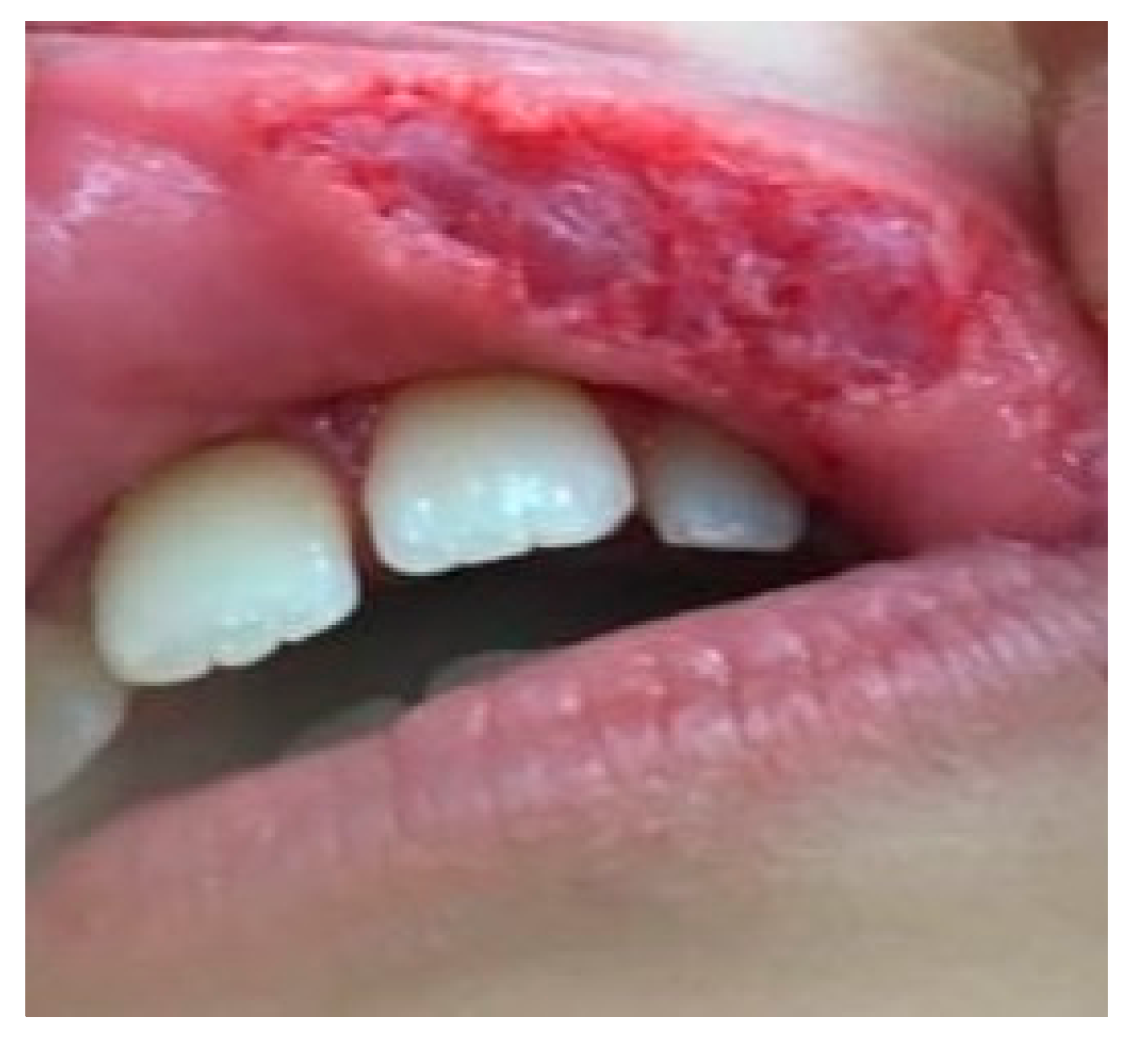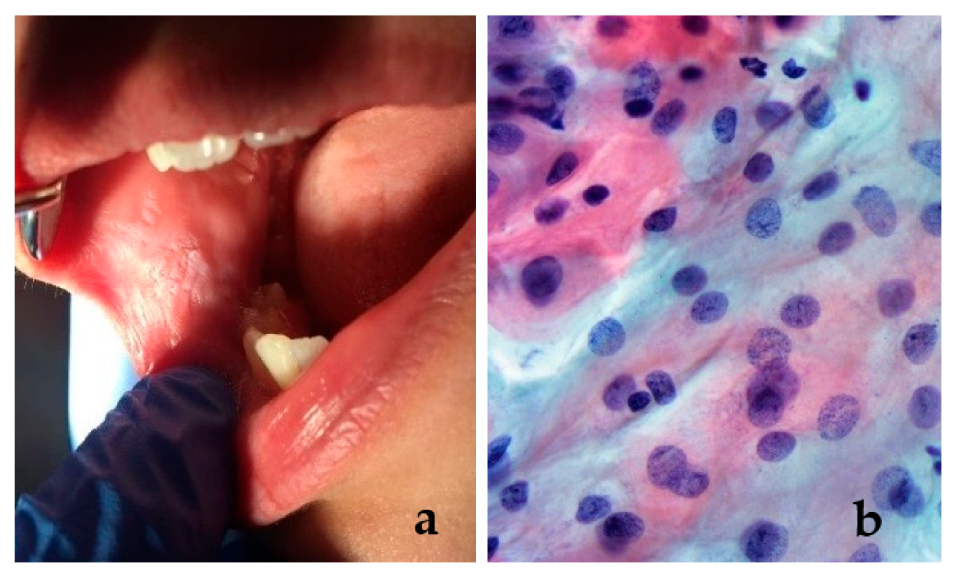The Correlation between Oral Self-Harm and Ethnicity in Institutionalized Children
Abstract
:1. Introduction
2. Materials and Methods
2.1. Study Design and Participants
2.2. Clinical and Histopathological Examination
2.3. Statistical Analysis
3. Results
4. Discussion
4.1. Clinical Relevance
4.2. Strengths and Limitations
Author Contributions
Funding
Institutional Review Board Statement
Informed Consent Statement
Data Availability Statement
Conflicts of Interest
References
- Klonsky, E.D.; Muehlenkamp, J.J. Self-injury: A research review for the practitioner. J. Clin. Psychol. 2007, 63, 1045–1056. [Google Scholar] [CrossRef] [PubMed]
- Walsh, B. Clinical assessment of self-injury: A practical guide. J. Clin. Psychol. 2007, 63, 1057–1068. [Google Scholar] [CrossRef]
- Greydanus, D.E.; Shek, D. Deliberate self-harm and suicide in adolescents. Keio J. Med. 2009, 58, 144–151. [Google Scholar] [CrossRef] [Green Version]
- Skegg, K. Self-harm. Lancet 2005, 366, 1471–1483. [Google Scholar] [CrossRef]
- Rosenthal, E. A Mandate to End Placement of Children in Institutions and Orphanages: The Duty of Governments and Donors to Prevent Segregation and Torture (16 February 2017). Prot. Child. Torture Deten. Glob. Solut. Glob. Probl. 2017. Available online: https://ssrn.com/abstract=3271306 (accessed on 12 November 2020).
- Dozier, M.; Zeanah, C.H.; Wallin, A.R.; Shauffer, C. Institutional Care for Young Children: Review of Literature and Policy Implications. Soc. Issues Policy Rev. 2012, 6, 1–25. [Google Scholar] [CrossRef] [Green Version]
- Nsabimana, E.; Rutembesa, E.; Wilhelm, P.; Martin-Soelch, C. Effects of Institutionalization and Parental Living Status on Children’s Self-Esteem, and Externalizing and Internalizing Problems in Rwanda. Front. Psychiatry 2019, 10, 442. [Google Scholar] [CrossRef] [Green Version]
- Vajani, M.; Annest, J.L.; Crosby, A.E.; Alexander, J.D.; Millet, L.M. Nonfatal and fatal self-harm injuries among children aged 10–14 years—United States and Oregon, 2001–2003. Suicide Life Threat. Behav. 2007, 37, 493–506. [Google Scholar] [CrossRef]
- Limeres, J.; Feijoo, J.F.; Baluja, F.; Seoane, J.M.; Diniz, M.; Diz, P. Oral self-injury: An update. Dent. Traumatol. 2013, 29, 8–14. [Google Scholar] [CrossRef]
- Johnson, D.E.; Tang, A.; Almas, A.N.; Degnan, K.A.; McLaughlin, K.A.; Nelson, C.A.; Fox, N.A.; CZeanah, C.H.; Drury, S.S. Caregiving Disruptions Affect Growth and Pubertal Development in Early Adolescence in Institutionalized and Fostered Romanian Children: A Randomized Clinical Trial. J. Pediatr. 2018, 203, 345–353.e3. [Google Scholar] [CrossRef]
- Sonuga-Barke, E.J.S.; Kennedy, M.; Kumsta, R.; Knights, N.; Golm, D.; Rutter, M.; Maughan, B.; Schlotz, W.; Kreppner, J. Child-to-adult neurodevelopmental and mental health trajectories after early life deprivation: The young adult follow-up of the longitudinal English and Romanian Adoptees study. Lancet 2017, 389, 1539–1548. [Google Scholar] [CrossRef] [Green Version]
- Dobrova-Krol, N.A.; van Ijzendoorn, M.H.; Bakermans-Kranenburg, M.J.; Cyr, C.; Juffer, F. Physical growth delays and stress dysregulation in stunted and non-stunted Ukrainian institution-reared children. Infant Behav. Dev. 2008, 31, 539–553. [Google Scholar] [CrossRef] [PubMed]
- Warner, H.A.; McCall, R.B.; Groark, C.J.; Kim, K.H.; Muhamedrahimov, R.J.; Palmov, O.I.; Nikiforova, N.V. Caregiver-child interaction, caregiver transitions, and group size as mediators between intervention condition and attachment and physical growth outcomes in institutionalized children. Infant Ment. Health J. 2017, 38, 645–657. [Google Scholar] [CrossRef] [PubMed]
- Flemming, M.; Aronson, L. Child Maltreatment and Non-Suicidal Self-Injury. Information Brief Series, Cornell Research Program on Self-Injury and Recovery. Cornell University Ithaca, NY. 2016. Available online: http://www.selfinjury.bctr.cornell.edu/perch/resources/the-relationship-between-child-maltreatment-and-non-suicidal-self-injuryfinal.pdf (accessed on 20 August 2020).
- DiPierro, R.; Samo, I.; Perego, S.; Galucci, M.; Madeddu, F. Adolescent non-suicidal self-injury: The effects of personality traits, family relationship and maltreatment on the presence and severity of behaviours. Eur. Child Adolesc. Psychiatry 2012, 21, 511–520. [Google Scholar] [CrossRef]
- Lang, C.M.; Sharma-Patel, K. The relation between childhood maltreatment and self-injury: A review of the literature on conceptualization and intervention. Trauma Violence Abuse 2011, 12, 23–37. [Google Scholar] [CrossRef]
- Muehlenkamp, J.J.; Xhunga, N.; Brausch, A.M. Self-injury Age of Onset: A Risk Factor for NSSI Severity and Suicidal Behavior. Arch. Suicide Res. 2019, 23, 551–563. [Google Scholar] [CrossRef]
- Buresova, I. Self-Harm classification system development: Theoretical study. Rev. Soc. Sci. 2016, 1, 3–20. [Google Scholar] [CrossRef]
- Madge, N.; Hewitt, A.; Hawton, K.; De Wilde, E.J.; Corcoran, P.; Fekete, S.; van Heeringan, K.; DeLeo, D.; Ystgaard, M. Deliberate self-harm within an international community sample of young people: Comparative findings from the Child & Adolescent Self-harm in Europe (CASE) Study. J. Child Psychol. Psychiatry 2008, 49, 667–677. [Google Scholar] [CrossRef]
- Cannavale, R.; Itro, A.; Campisi, G.; Compilato, D.; Collella, G. Oral self-injuries: Clinical findings in a series of 19 patients. Med. Oral Pathol. Oral Cir. Bucal 2015, 20, e123. [Google Scholar] [CrossRef]
- Klonsky, E.D. Non-suicidal self-injury in United States adults: Prevalence, sociodemographics, topography and functions. Psychol. Med. 2011, 41, 1981–1986. [Google Scholar] [CrossRef]
- Gratz, K.L.; Conrad, S.D.; Roemer, L. Risk factors for deliberate self-harm among college students. Am. J. Orthopsychiatry 2002, 72, 128–140. [Google Scholar] [CrossRef]
- Withlock, J.; Eckenrode, J.; Silverman, D. Self-injurious behaviors in a college population. Pediatrics 2006, 117, 1939–1948. [Google Scholar] [CrossRef] [Green Version]
- Lloyd-Richardson, E.E.; Perrine, N.; Dierker, L.; Kelley, M.L. Characteristics and functions of non-suicidal self-injury in a community sample of adolescents. Psychol. Med. 2007, 37, 1183–1192. [Google Scholar] [CrossRef] [PubMed] [Green Version]
- Wilkinson, B. Current trends in remediating adolescent self-injury: An integrative review. J. Sch. Nurs. 2011, 27, 120–128. [Google Scholar] [CrossRef] [PubMed]
- Yates, T.M.; Carlson, E.A.; Egeland, B. A prospective study of child maltreatment and self-injurious behavior in a community sample. Dev. Psychopathol. 2008, 20, 651–671. [Google Scholar] [CrossRef] [PubMed]
- Brunner, R.; Parzer, P.; Haffner, J. Prevalence and psychological correlates of occasional and deliberate self-harm in adolescents. Arch. Pediatr. Adolesc. Med. 2007, 161, 641–649. [Google Scholar] [CrossRef] [PubMed] [Green Version]
- Portzky, G.; De Wilde, E.J.; van Heeringen, K. Deliberate self-harm in young people: Differences in prevalence and risk factors between the Netherlands and Belgium. Eur. Child Adolesc. Psychiatry 2008, 17, 179–186. [Google Scholar] [CrossRef]
- Tóth, M.D.; Ádám, S.; Zonda, T.; Birkás, E.; Purebl, G. Risk factors for multiple suicide attempts among Roma in Hungary. Transcult. Psychiatry 2018, 55, 55–72. [Google Scholar] [CrossRef] [Green Version]
- Lang, J.; Yao, Y. Prevalence of nonsuicidal self-injury in Chinese middle school and high school students. A meta-analysis. Medicine 2018, 97, e12916. [Google Scholar] [CrossRef]
- AlSadhan, S.A.; Al-Jobair, A.M. Oral habits, dental trauma, and occlusal characteristics among 4- to 12-year-old institutionalized orphan children in Riyadh, Saudi Arabia. Spec. Care Dent. 2017, 37, 10–18. [Google Scholar] [CrossRef]
- Millogo, M.; Ouedraogo, R.W.L.; Ily, V.; Konsem, T.; Ouedraogo, D. Labial lesions by human bite. J. Oral Med. Oral Surg. 2018, 24, 153–156. [Google Scholar] [CrossRef]
- Kostic, J.; Zikic, O.; Stankovic, M.; Nikolic, G. Nonsuicidal self-injury among adolescents in south-east Serbia. Int. J. Pediatr. Adolesc. Med. 2019, 6, 131–134. [Google Scholar] [CrossRef] [PubMed]
- Tang, J.; Yang, W.; Ahmed, N.I.; Ma, Y.; Liu, H.Y.; Wang, J.J.; Wang, P.X.; Du, Y.K.; Yu, Y.Z. Stressful Life Events as a Predictor for Nonsuicidal Self-Injury in Southern Chinese Adolescence. A Cross-Sectional Study. Medicine 2016, 95, e2637. [Google Scholar] [CrossRef]
- Tortorici, S.; Corrao, S.; Natoli, G.; Difalco, P. Prevalence and distribution of oral mucosal non-malignant lesions in the western Sicilian population. Minerva Stomatol. 2016, 65, 191–206. [Google Scholar] [PubMed]
- Hailegiorgis, M.T.; Berheto, T.M.; Sibamo, E.L.; Asseffa, N.A.; Tesfa, G.; Birhanu, F. Psychological wellbeing of children at public primary schools in Jimma town: An orphan and non-orphan comparative study. PLoS ONE 2018, 13, e0195377. [Google Scholar] [CrossRef] [Green Version]
- Monea, M.; Olah, P.; Comaneanu, R.M.; Hancu, V.; Ormenisan, A. The Role of Toluidine Blue as a Visual Diagnostic Method in Oral Premalignant Lesions. Rev. Chim. 2016, 67, 1370–1372. [Google Scholar]



| Gender/Ethnicity | Romanians | Hungarians | Roma | Total |
|---|---|---|---|---|
| Female | 20 (17.24%) | 19 (16.38%) | 24 (20.69%) | 63 (54.31%) |
| Male | 17 (14.65%) | 15 (12.93%) | 21 (18.11%) | 53 (45.69%) |
| Total | 37 (31.89%) | 34 (29.31%) | 45 (38.8%) | 116 (100%) |
| Gender/Oral Lesion | Oral Lesion Present | Oral Lesion Absent | Total |
|---|---|---|---|
| Female | 16 (13.79%) | 47 (40.52%) | 63 (54.31%) |
| Male | 5 (4.31%) | 48 (41.38%) | 53 (45.69%) |
| Total | 21 (18.1%) | 95 (81.9%) | 116 (100%) |
| Ethnicity/Oral Lesion | Oral Lesion Present | Oral Lesion Absent | Total |
|---|---|---|---|
| Romanian | 2 (1.72%) | 35 (30.17%) | 37 (31.89%) |
| Hungarian | 7 (6.03%) | 27 (23.28%) | 34 (29.31%) |
| Roma | 12 (10.35%) | 33 (28.45%) | 45 (38.8%) |
| Total | 21(18.1%) | 95 (81.9%) | 116 (100%) |
| Location of Lesion | Number | Frequency |
|---|---|---|
| Upper lip | 6 | 19.36% |
| Lower lip | 4 | 12.90% |
| Tongue | 1 | 3.23% |
| Buccal mucosa | 9 | 29.03% |
| Commissures | 11 | 35.48% |
Publisher’s Note: MDPI stays neutral with regard to jurisdictional claims in published maps and institutional affiliations. |
© 2020 by the authors. Licensee MDPI, Basel, Switzerland. This article is an open access article distributed under the terms and conditions of the Creative Commons Attribution (CC BY) license (http://creativecommons.org/licenses/by/4.0/).
Share and Cite
Stoica, A.M.; Stoica, O.E.; Vlad, R.E.; Pop, A.M.; Monea, M. The Correlation between Oral Self-Harm and Ethnicity in Institutionalized Children. Children 2021, 8, 2. https://doi.org/10.3390/children8010002
Stoica AM, Stoica OE, Vlad RE, Pop AM, Monea M. The Correlation between Oral Self-Harm and Ethnicity in Institutionalized Children. Children. 2021; 8(1):2. https://doi.org/10.3390/children8010002
Chicago/Turabian StyleStoica, Alexandra Mihaela, Oana Elena Stoica, Ramona Elena Vlad, Anca Maria Pop, and Monica Monea. 2021. "The Correlation between Oral Self-Harm and Ethnicity in Institutionalized Children" Children 8, no. 1: 2. https://doi.org/10.3390/children8010002




